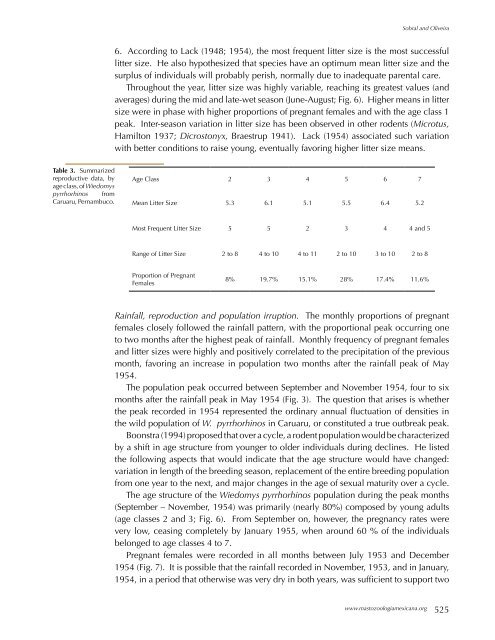therya-5_2
therya-5_2
therya-5_2
You also want an ePaper? Increase the reach of your titles
YUMPU automatically turns print PDFs into web optimized ePapers that Google loves.
Sobral and Oliveira<br />
6. According to Lack (1948; 1954), the most frequent litter size is the most successful<br />
litter size. He also hypothesized that species have an optimum mean litter size and the<br />
surplus of individuals will probably perish, normally due to inadequate parental care.<br />
Throughout the year, litter size was highly variable, reaching its greatest values (and<br />
averages) during the mid and late-wet season (June-August; Fig. 6). Higher means in litter<br />
size were in phase with higher proportions of pregnant females and with the age class 1<br />
peak. Inter-season variation in litter size has been observed in other rodents (Microtus,<br />
Hamilton 1937; Dicrostonyx, Braestrup 1941). Lack (1954) associated such variation<br />
with better conditions to raise young, eventually favoring higher litter size means.<br />
Table 3. Summarized<br />
reproductive data, by<br />
age class, of Wiedomys<br />
pyrrhorhinos from<br />
Caruaru, Pernambuco.<br />
Age Class 2 3 4 5 6 7<br />
Mean Litter Size 5.3 6.1 5.1 5.5 6.4 5.2<br />
Most Frequent Litter Size 5 5 2 3 4 4 and 5<br />
Range of Litter Size 2 to 8 4 to 10 4 to 11 2 to 10 3 to 10 2 to 8<br />
Proportion of Pregnant<br />
Females<br />
8% 19.7% 15.1% 28% 17.4% 11.6%<br />
Rainfall, reproduction and population irruption. The monthly proportions of pregnant<br />
females closely followed the rainfall pattern, with the proportional peak occurring one<br />
to two months after the highest peak of rainfall. Monthly frequency of pregnant females<br />
and litter sizes were highly and positively correlated to the precipitation of the previous<br />
month, favoring an increase in population two months after the rainfall peak of May<br />
1954.<br />
The population peak occurred between September and November 1954, four to six<br />
months after the rainfall peak in May 1954 (Fig. 3). The question that arises is whether<br />
the peak recorded in 1954 represented the ordinary annual fluctuation of densities in<br />
the wild population of W. pyrrhorhinos in Caruaru, or constituted a true outbreak peak.<br />
Boonstra (1994) proposed that over a cycle, a rodent population would be characterized<br />
by a shift in age structure from younger to older individuals during declines. He listed<br />
the following aspects that would indicate that the age structure would have changed:<br />
variation in length of the breeding season, replacement of the entire breeding population<br />
from one year to the next, and major changes in the age of sexual maturity over a cycle.<br />
The age structure of the Wiedomys pyrrhorhinos population during the peak months<br />
(September – November, 1954) was primarily (nearly 80%) composed by young adults<br />
(age classes 2 and 3; Fig. 6). From September on, however, the pregnancy rates were<br />
very low, ceasing completely by January 1955, when around 60 % of the individuals<br />
belonged to age classes 4 to 7.<br />
Pregnant females were recorded in all months between July 1953 and December<br />
1954 (Fig. 7). It is possible that the rainfall recorded in November, 1953, and in January,<br />
1954, in a period that otherwise was very dry in both years, was sufficient to support two<br />
www.mastozoologiamexicana.org<br />
525



